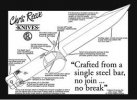I'm primarily referring to the tang.
It would be the same question as asking why one would choose, say, a stick tang over a half tang, or a full tang over a stick tang. If the tang didn't matter, then everyone should choose the smallest tang as it requires the least amount of effort to build. But, it clearly does matter to different people for different tasks. So then, is a full tang the best tang construction? Asking about the other parts is relevant to the overall integrity of the knife, but as far as the specific tang shape is concerned, I'd think it would have less bearing than discussing the tang's shape itself.






